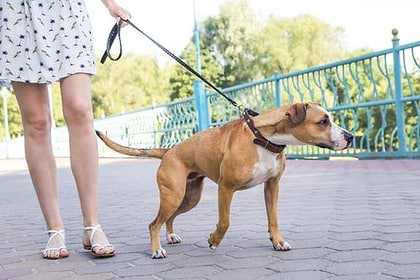
Whether you have just adopted a puppy or you are rescuing an adult or older dog, you are likely noticing many of their quirks for the first time. Perhaps they tend to snore or they really love certain toys. There might be some quirks that are slightly more difficult to deal with though, like being overly sensitive to touch.
There are many reasons that a dog could be resistant to touch. It is possible that they were not socialized enough as a puppy, so they are now reluctant to accept touch in their adulthood. It is also a possibility that they were handled roughly in the past, meaning that they are fearful about it now.
Then, there are simply dogs who are more independent and do not feel the need to be pet as much as other dogs. No matter the reason, if you are looking to help your dog become more comfortable with the idea of being touched, this is the article for you.
What Parts of a Dog’s Body Are Especially Sensitive to Touch?
It is also possible that your dog is not against being pet, they are simply a bit pickier about where they are touched. While this will vary somewhat from dog to dog, there are a few places that our canine companions classically do not enjoy being pet.
The Head and Face
If you notice your dog regularly bowing their head in response to your attempts to pet them there, this is not an accident. In reality, your dog is probably trying to both avoid being stroked on their face, and they are also trying to communicate that they do not enjoy that. Many dogs do not enjoy being touched on their head and face specifically. Instead, try gently petting their shoulders or chest, as many dogs enjoy a nice rub in those spots.
Their Paws
This principle seems to travel across all sorts of different kinds of pets, but many dogs do not enjoy having their paws touched or messed with. Even if you do not regularly go around lovingly petting your dog’s paws, this can become a slightly more complicated issue when it comes to cutting their nails. Trimming a dog’s nails is an important part of their grooming.
This process benefits humans because the possibility of accidental scratching is greatly diminished (and your furniture is likely to thank you). Meanwhile, nail trimming is also helpful for dogs because, without it, they will just keep growing and eventually become painful. The nails are also more likely to split or become infected, as they continue to grow longer and longer.
If your dog does not allow you to touch their paws even with training, it might become necessary to take them to a groomer to cut their nails. However, with diligent training with an abundance of treats and love, you might be able to get them more comfortable with the idea of having their nails done.
Their Belly
While it is true that some dogs might love nothing more than a nice belly scratch from time to time (or, for some dogs, all of the time), others might not find this kind of touch appealing. Rolling over and exposing the stomach is a very vulnerable position for animals. As a result, this position is typically not one that dogs will take unless they are either especially comfortable or are trying to show submission.
It is crucial as a pet parent to be able to distinguish between these two possibilities in your dog. If they want a belly rub, then leaning down for some quality petting time would certainly be much appreciated by your dog. However, if this is a submissive gesture by a nervous dog, petting them in such a vulnerable area could only serve to make them more anxious.
If you are not sure what signs to look out for to determine if your dog is asking for pets or nervously showing submission, here are some helpful reminders. A happy dog is likely to have an open mouth, with their tongue lolling around without a care. You might hear slight panting through their open mouth and their eyes will be either squinted or just not focused on anything in particular. A loosely wagging tail is also an excellent indication of a dog who is ready for your attention.
Meanwhile, the possibility that your dog’s anxiety is the cause of them rolling over should not be ignored. If this is the case, you are likely to see that their entire body will be much tenser. They might be staring at you or at another perceived threat. Also, they could be licking their lips, which is a common sign of anxiety in dogs. You will notice their tail is tense, but it might still be wagging. This can be slightly confusing to dog owners since tail wagging is so closely associated with happiness. Make sure to really pay attention to the specific movements their tail is making.
Although all of these signs are undoubtedly helpful when determining the motive behind your dog rolling over like this, the most foolproof method is to know your dog and understand their body language. Not only will this help you significantly in this situation, but this is invaluable knowledge in countless other situations with your dog as well.
How Can You Help a Dog Learn To Like Being Touched?
Now that we have covered the basics of dogs and touch sensitivity, let’s establish how you can go about possibly making your dog more comfortable with being petted. With enough patience and understanding on your part, they could potentially even learn to enjoy it.
Create a Relaxing Atmosphere
The first step in making your dog more comfortable with being touched is to create an atmosphere conducive to relaxation and learning. Lay down some soft blankets or mats, and do not be afraid to put on some calming music. Maybe include your dog’s favorite toys that never cease to make them feel more at peace. Know your dog, know what makes them feel confident and relaxed, and implement it however possible.
Make Sure That You Are Calm When Approaching Them
It is no secret that dogs are super sleuths at reading the energy of a room. In fact, it is possible that they even have the ability to combine their understanding of your facial expressions along with your tone of voice. They then use these two pieces of information to determine how you are feeling.
Since dogs are so profoundly sensitive in this way, it is integral that you approach them in a calm manner when starting any training exercise. If a dog is not in a relaxed, happy mood, then they will associate this experience with negative emotions. That will make it even more difficult to teach them to tolerate or even enjoy touch. Due to all this, it is much better to just enter this experience with a calm and open mind for the sake of both you and your dog.
Do Not Hesitate To Give Them Lots of Treats
No, your dog did not write this section. Many pets are very food motivated in addition to being eager to please. Have a wide variety of their favorite treats at the ready when it is time to get them more acquainted with touch. If you give them treats often when they are relaxed or do something worthy of being rewarded, then they will come to understand that touch equals a positive experience.
Be Patient
This is perhaps the most important tip of them all. While the technique with which you go about teaching your dog to accept touch is certainly important, you can’t expect them to go from zero to 100 overnight. Even the most attentive and perfect training will take some time to work, so remember that this is a process that needs to happen in its own time.
Trying to rush your dog will cause them to become overwhelmed or uncomfortable, so it is crucial to move on their timetable instead of your own.
Start by Petting Spots That Your Dog Is More Comfortable With
As you are training your dog to like touch, you should not start out by petting them in spots they are unlikely to enjoy. Stay away from the head and face, the paws, and the stomach. Instead, try giving them a nice pet on their chest or shoulders. Many dogs enjoy being stroked along those areas, but be cognizant of the fact that your pet might not be one of them. No matter what, be gentle in how you pet them. That brings us to our next point.
Be Aware of How You Pet Your Dog
In many ways, how you pet your dog is nearly as important as where you pet your dog. Dogs tend to prefer long and gentle strokes through the fur, rather than aggressive scratching or sudden movements. Especially as your dog is just now becoming more accustomed to receiving this kind of affection, make sure that they can see where your hand is going at all times. After all, this is not at all a situation in which surprise is welcomed.
Keep Sessions Short at First
This tip is along the same lines of being patient, and it is similarly important. If you prolong sessions too much at the beginning, your dog could become overwhelmed and uncomfortable. Instead, keep training sessions down to five minutes or less when you are first starting out.
Then, as they begin to enjoy touch more and more, you can make the sessions a bit longer. All the while, be very aware of how your dog is doing by observing their body language and vocalizations.
Build Trust Through Other Fun Activities
Even after you do your absolute best to show your dog the many joys of petting, it is possible that they still will not be its biggest fan. This is not cause for alarm, but if you have more questions, do not hesitate to ask your vet.
However, there are still a wide variety of ways that you and your dog can enjoy your lives together. Try playing fetch with them, or engaging with them using their favorite toy. Taking a nice walk together can also make for a lovely bonding experience.
The Wrap Up
No matter the reason that your dog is not currently crazy about being touched, it is likely that you want to get them more comfortable with it. Luckily, there are a variety of techniques and methods that you can use to accomplish this goal. As long as you are patient and understand what your dog is trying to tell you, you can make a great deal of progress together.
Sources:
What Is the Meaning of Lip Licking or Air Licking in Dogs? | Psychology Today
Your Dog Can Hear Your Emotions, Research Shows | American Kennel Club
Dog Sensitive to Being Touched or Handled | Best Friends Animal Society

The Diggs Team
We believe our dogs deserve safer, better designed pet products.
You might also like
Crate training tips, stories and inspiration
View all blogsIn Your Diggs
Share your photos with #DiggsPet and tag us @DiggsPet on IG and TikTok.


